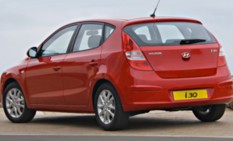Review
A new compact family car is set to revitalise Hyundai by winning vital business in the UK fleet market.
The i30 will go head-to-head with the Ford Focus, Renault Megane and Peugeot 307 when it reaches showrooms in September and the South Korean carmaker expects it to transform its image.
Marketing director Jim Campbell believes the i30 – the first Hyundai designed and built in Europe – will double the company’s penetration in the business sector from next year.
He said: “We are breaking the mould with this car. It ticks all the boxes in terms of value, styling and performance and will make us a force to be reckoned with in the lower-medium sector. It has tremendous potential and we think it makes us well worth a second look by business car decision makers.”
Speaking at the launch of the five-door model in Austria, he revealed that the i30 is set to pave the way for a succession of new products designed to appeal to family and company car users.
Mr Campbell added: “We will launch a sporty estate version of the i30 called the CW early next year and we’re looking at producing a three-door version, a coupe-cabriolet, a GTi variant and even an MPV. This means we can field a full line-up in one of the most important markets in Europe.”
The launch of the i30 also heralds a new naming strategy, as Hyundai has decided to drop model names in favour of an alpha-numeric system because it feels this is more in line with the quality and technology of its next-generation products.
When it arrives early next year the Amica replacement will be called i10, and the new Getz, due out in early 2009, will be the i20.
Additionally, next year’s Sonata replacement will be the i40 and Hyundai is planning for an i50 car in the executive segment. Its new SUV and sports coupe models will also be included in the new badging theme.
The manufacturer believes this new approach and a greater focus on European style and build quality will help it boost registrations in the UK.
Mr Campbell said: “Fleet registrations accounted for only 3,000 of our total of 34,000 UK registrations last year, but the i30 represents the start of a new era. It is the right product to help us develop sustainable business in a segment that is 60% fleet.”
Hyundai expects to sell 11,000 i30 models in the UK next year, with fleet sales accounting for 60% of registrations. Hyundai’s milestone five-door hatchback will come with 1.4 and 1.6-litre petrol engines and 1.6 and 2.0-litre turbodiesels.
14 versions will be launched in the autumn and potential buyers will have three trim levels to choose from. Specifications will be high, with the base Comfort version including alloy wheels, an electronic stability programme, traction control, air conditioning, an audio system with MP3 and iPod compatibility and steering wheel audio controls.
Hyundai Motor UK managing director Tony Whitehorn said: “As the new boys in the segment we have a tough job to do, but we think we have a strong proposition with specification-adjusted prices showing the i30 to be up to 40% cheaper than the Focus and 48% cheaper than the Astra.
“Historically, we have been weak on SMR but we’re now fully competitive and our premiums of £700 for diesel and £1,000 for automatic transmission round off an attractive range.”
Behind the wheel
It’s no coincidence that the i30 bears more than a passing resemblance to the BMW 1 Series from some angles – the rear-end design is strikingly similar – and its bootlid nomenclature has taken on an upmarket air.
But while Hyundai can be accused of mimicking the premium German brand in some areas of styling, it has to be congratulated for delivering an attractive, well-packaged vehicle that achieves high standards of roadholding and handling.
Even though European suspension settings have yet to be finalised, the spacious five-seater provides a better, more involving drive than the company’s supposedly sporty Coupe.
The best Hyundai so far has excellent fit and finish and neat detailing. Every version has a large cooled glovebox, storage compartments are trimmed and standard items such as two-way adjustable steering and height and lumbar adjustment guarantee driving comfort over long distances.
Best sellers are likely to be the entry-level 1.4-litre version and the mid-range 1.6-litre diesel, which will also be available with automatic transmission at launch.
Of the cars we sampled, the smaller diesel was the star with a surprising blend of performance, power and refinement.
The i30’s long wheelbase provides generous room for five. With a near-60mpg fuel economy potential in real-world driving, the smaller diesel version looks a worthy user-chooser contender.
Verdict
Hyundai is celebrating its 25th anniversary in style with the i30, a model that shows the firm has achieved its aim of matching its Japanese rivals in all areas.
| Model | 1.4 | 1.6 | 1.6 CRDi | 2.0 CRDi | ||||
| Max power (bhp/rpm): | 107/6,200 | 120/6,200 | 113/4,000 | 138/3,800 | ||||
| Max torque (lb-ft/rpm): | 101/5,000 | 113/4,200 | 188/1,900 | 224/2,500 | ||||
| Max speed (mph): | 116 | 119 | 116 | 127 | ||||
| 0-62mph (secs): | 12.6 | 11.1 | 11.6 | 10.3 | ||||
| Fuel consumption (mpg): | 46.3 | 45.5 | 60.1 | 51.4 | ||||
| CO2 emissions (g/km): | 145 | 152 | 125 | 191 | ||||
| On sale: | September 1 | |||||||
| Prices (OTR): | £10,995–£16,595 | |||||||
















